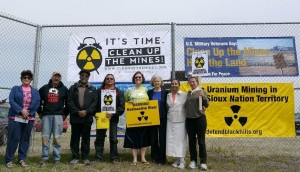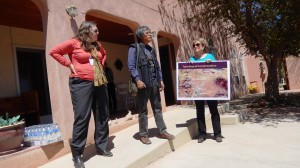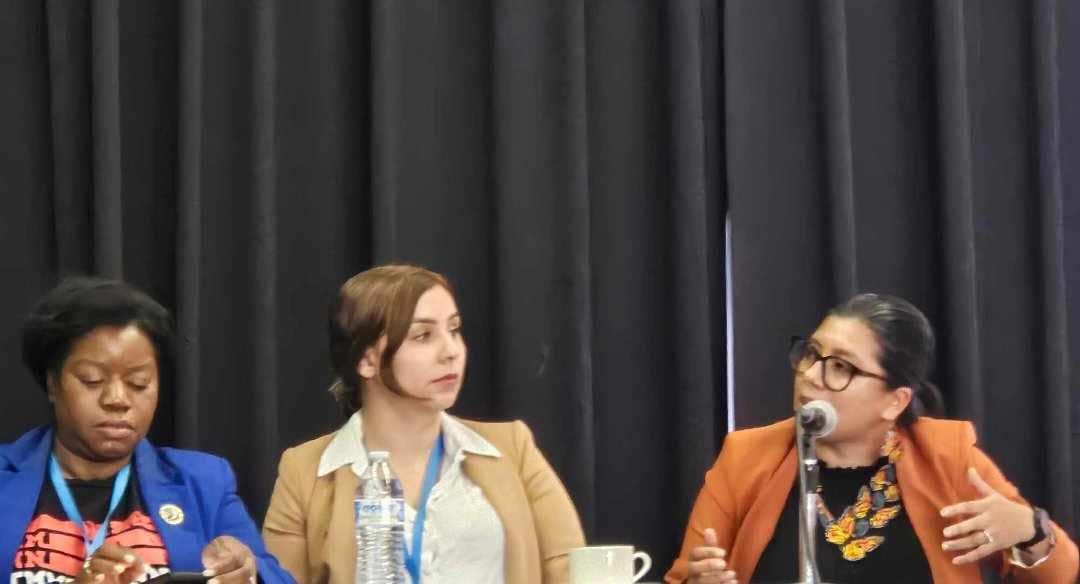 With the imminent release of a congressionally mandated report on the legacy of abandoned uranium mines in the United States, peace and environmental justice advocates are rallying for a nationwide clean-up.
With the imminent release of a congressionally mandated report on the legacy of abandoned uranium mines in the United States, peace and environmental justice advocates are rallying for a nationwide clean-up.
Nearly 100 people from both grassroots and high-profile environmental groups across the country gathered in Albuquerque, New Mexico, May 1-5 to strategize about reducing the devastating role of uranium mining in the nuclear energy cycle and to challenge the growth of other non-renewable energy industries.
Taking part in the Third Extreme Energy Extraction Summit, activists from throughout the uranium mining territory of the Inter-Mountain West linked up to inform themselves of opportunities for working together on a shared agenda.
Chief among prospects for progress they discussed was the recent $5.15 billion settlement of a landmark lawsuit against Kerr-McGee and its parent Anadarko Petroleum Corp., for fraud in the abandonment of some 2,700 uranium and other hazardous and mining sites in 47 states.
The U.S. Justice Department, lead plaintiff in the case, announced the settlement on April 3, noting that $4.4 billion of it will go to fund environmental recovery and related claims, in what it called “the largest payment ever for the clean-up of environmental contamination.”
Native Americans, among populations most severely impacted by the hazards of the abandoned uranium mines, have drafted language for federal legislation to ban any further uranium mining until the so-called legacy sites have been remediated.
Looking for congressional sponsors for the proposed Uranium Exploration and Mining Accountability Act, the Flagstaff, Arizona-based Clean Up The Mines and the Rapid City, South Dakota-based Defenders of the Black Hills teamed up to launch a national grassroots campaign for the ban on Earth Day April 22.
More than 10,000 abandoned uranium mines have been identified across the United States, primarily in the West, and more than 10 million people live within a 50-mile radius of one, they said.
According to the draft report to the U.S. Congress, the six states that have the most abandoned uranium mines within their boundaries are Arizona (416), Colorado (1,347), New Mexico (249), South Dakota (155), Utah (1,376), and Wyoming (319).
Organizers from these states attending the Extreme Energy Extraction Summit noted that the downside of the settlement with Kerr-McGee and Anadarko is online casino that it protects the polluters from 4,000 additional claims pending against them for clean-up, leaving the taxpayers to foot the bill for the remaining mess.
Among the leadership present were participants in the Albuquerque-based Multicultural Alliance for Safe Energy (MASE), which adopted the Nuclear-Free Zone Declaration for the Grants Mineral Belt and Northwest New Mexico in October 2012.
The organization opposes any new mining of uranium until the government carries out effective programs of reclamation of ground water, soil and air contamination from historic uranium exploitation. .
Its core member groups are Bluewater Valley Downstream Alliance, Eastern Navajo Diné Against Uranium Mining, Laguna Acoma Coalition for a Safe Environment, Post 71 Uranium Workers Committee, and Red Water Pond Road Community Association.
Their declaration informally extends the reach of the Navajo Nation’s laws – forbidding mining and transport of uranium – to surrounding areas of influence in the Southwestern United States.
Joining MASE representatives at the Extreme Energy Extraction Summit were members of the multi-state membership Western Organization of Resource Councils (WORC) who are victims of historic and proposed uranium mining. WORC’s constituent Western Colorado Congress recently ousted a foreign uranium speculator by strengthening state laws. The organization’s Dakota Rural Action contingent, facing uranium development schemes on previously mined territory, operates under a South Dakota statewide grassroots resolution to prevent any new uranium mining until the process can be proven safe.
Following the Extreme Energy Extraction Summit, several attendees and other people from allied organizations carried on the uranium mining discussion at a Western Mining Action Network trans-boundary meeting, which took place in Anchorage, Alaska.
The network, based in Billings, Montana, has provided a critical forum for more than a decade for communities facing mining in the United States and Canada. It was among sponsors of the groundbreaking Uranium Confab in Moab, Utah, in May 2012, which promoted shared grassroots strategies in Southwest U.S. clean energy action.
The confab occurred at about the same time the national non-profit Natural Resources Defense Council released its report called “Nuclear Fuel’s Dirty Beginnings: Environmental Damage and Public Health Risks from Uranium Mining in the American West.”
The report recommends the EPA and NRC go back to the drawing board to strengthen health and environmental protections from uranium mining. It asserts that the agencies have overlooked the cumulative impacts of the industry on the American West.
Low-income communities and minority populations have been disproportionately affected by uranium mining, “representative of an all too common pattern of environmental and economic injustice with respect to resource extraction,” the report noted.
Demanding stiffer regulations and clean-up as requisites to any new mining is a practical way to rally various organizations under the same banner.
Rallying together is particularly important given the onslaught of new mining proposals being carried out in the wake of pre-Fukushima projections of a global “nuclear renaissance.”
The next step for the uranium-mining clean-up movement should be to use channels now initiated to organize a strategy conference gathering as many constituents as possible from affected areas to build on the steps already taken to kneecap nukes at the front end of the atomic energy cycle.
The movement can be broadened for better effectiveness by consolidating national ties and reaching out to allies across international boundaries who are working on ending nuclear proliferation, reducing energy consumption, and promoting sustainable renewable energy alternatives.



